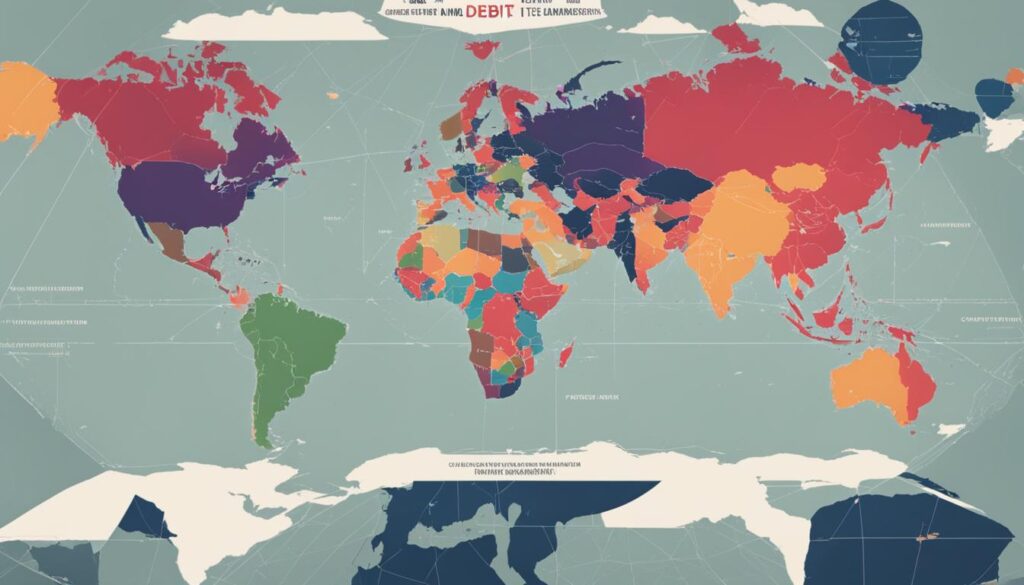A debt crisis in one country can have far-reaching effects on other countries and their economies. Financial conditions such as interest rate spikes, trade slowdowns, and declines in consumer confidence can spread economic pain. The global financial crisis of 2007-2008, originating from the US subprime mortgage market, showed how a debt crisis can have severe consequences worldwide. Debt crises can lead to financial losses, market turmoil, higher interest rates, job losses, and a plunge in economic activity.
Key Takeaways:
- Global debt can have a significant impact on personal finances and financial risk.
- A debt crisis in one country can have far-reaching economic consequences.
- The global financial crisis of 2007-2008 highlighted the severe effects of a debt crisis.
- Debt crises can lead to financial losses, market turmoil, higher interest rates, and job losses.
- It is crucial to understand the risks of global debt and its potential impact on your finances.
Understanding Debt Crises and Their Effects
A debt crisis occurs when a country is unable to pay its creditors what it owes, which can lead to higher borrowing costs and eventual default. Debt crises can have steep losses for banks, cause economic slowdowns, and affect individuals through rising costs of goods and services, higher interest rates, job losses, and a descent into poverty.
One of the most notable examples of a debt crisis and its effects is the global financial crisis of 2007-2008, which originated from the US subprime mortgage market. This crisis had widespread consequences worldwide, including financial losses, market turmoil, higher interest rates, and a plunge in economic activity.
In addition to the global financial crisis, there have been other debt crises in the past that illustrate the wide-ranging effects on economies and people. The Asian and Latin American debt crises serve as stark reminders of the economic slowdowns and recessions that can result from unsustainable levels of debt.
To better illustrate the effects of debt crises, consider the following table:
| Effects of Debt Crises | Description |
|---|---|
| Economic Slowdown | A debt crisis can lead to a decline in economic activity, lower GDP growth, and reduced business investment. |
| Recession | A severe debt crisis can push an economy into a recession, characterized by falling GDP, high unemployment rates, and declining consumer spending. |
| Debt Defaults | Countries facing a debt crisis may default on their obligations, leading to financial losses for creditors and a loss of confidence in the country’s ability to repay its debts. |
These examples and effects of debt crises highlight the significant challenges they pose to both economies and individuals. It is crucial for policymakers and governments to actively manage debt levels and take steps to prevent and mitigate the adverse effects of debt crises.
The Risks of Global Debt and Fragmentation
Excessive levels of global debt, both public and private, pose significant risks to economic growth and financial stability. When debt reaches unsustainable levels, it can have a detrimental impact on economies, leading to fragmentation and potential crises. Debt sustainability is crucial for maintaining a healthy economic environment, but determining the threshold for manageable debt is complex and varies across countries.
One of the risks associated with excessive debt is the crowding-out effect. When governments and businesses accumulate high levels of debt, it can limit their ability to consume and invest, which can hinder economic growth. Additionally, high debt levels can jeopardize fiscal stability, making it challenging for governments to implement effective policies and provide essential public services.
To mitigate the risks of high debt levels, governments should prioritize containing fiscal deficits and implementing structural reforms. This includes measures such as improving the business environment, labor market reforms, and fiscal responsibility laws. By addressing these factors, countries can enhance their debt sustainability and reduce the potential negative consequences of excessive debt.
The Fragmentation Risks
Fragmentation is a potential consequence of excessive global debt, particularly when economic agents and policymakers face challenges caused by geopolitical tensions and supply-side shocks. Fragmentation refers to the breakdown of the global financial system, where economies become disconnected and operate independently, leading to significant economic disruptions.
When fragmentation occurs, it becomes challenging for countries to coordinate and respond effectively to economic crises. Financial markets may become unstable, and investor confidence can decline, resulting in capital flight and market volatility. This can exacerbate debt problems, making it difficult for countries to access affordable financing and increasing the risk of default.
Addressing the risks of global debt and fragmentation requires proactive measures from governments and policymakers. This includes implementing targeted fiscal assistance programs, prioritizing debt resolution mechanisms, and promoting sustainable economic growth. By taking these steps, countries can reduce the vulnerability to excessive debt and promote financial stability in a globalized economy.
Addressing the Challenges of Global Debt
As the world grapples with the complexities of global debt, it becomes increasingly important to adopt a practical and strategic approach. Strengthening the international trade system is a key component in addressing the challenges posed by rising global debt levels. By implementing reforms within the World Trade Organization and pursuing market-opening agreements, we can create a more robust and resilient global financial landscape.
Another crucial aspect of tackling global debt is finding effective solutions for debt resolution and debt restructuring. It is essential to establish clearer processes, standards, and timelines to guide countries through systematic debt restructuring. This will enable vulnerable nations to effectively manage their debt burdens and foster economic stability.
Climate action is an integral part of addressing global debt. By stepping up efforts to combat climate change, we can mitigate the risks associated with high debt levels and create a more sustainable future. One potential approach is the implementation of an international carbon price floor, accompanied by increased climate finance. This would provide countries with the necessary resources to transition towards greener economies and reduce their reliance on debt.
Furthermore, implementing structural reforms can play a significant role in reducing debt burdens and promoting sustainable economic growth. Reforms aimed at improving business conditions, labor markets, and fiscal policies can enhance productivity, create job opportunities, and ensure the efficient use of resources. By prioritizing such reforms, governments can address the root causes of excessive debt and pave the way for long-term financial stability.
| Actions to Address Global Debt Challenges | Impact |
|---|---|
| Strengthening the international trade system | Enhanced economic resilience and stability |
| Clearer processes, standards, and timelines for debt resolution | Improved debt management and economic stability |
| Stepping up climate action and implementing measures such as an international carbon price floor | Reduced environmental risks and enhanced debt sustainability |
| Implementing structural reforms to improve business conditions, labor markets, and fiscal policies | Enhanced productivity, job creation, and long-term financial stability |

In conclusion, addressing the challenges of global debt requires a multifaceted approach that encompasses strengthening the international trade system, implementing effective debt resolution mechanisms, prioritizing climate action, and undertaking structural reforms. By taking decisive action in these areas, we can mitigate the risks associated with high debt levels, promote economic stability, and build a more sustainable future for generations to come.
The Role of Governments in Debt Management
Governments play a crucial role in managing debt and ensuring the stability of their economies. One key aspect of debt management is containing fiscal deficits. By controlling government spending and increasing revenue through taxation or other means, governments can reduce the need for borrowing and limit the accumulation of debt.
Another important tool in debt management is implementing medium-term fiscal frameworks. These frameworks provide a strategic plan for managing government finances over a defined period, typically three to five years. By setting clear targets for fiscal sustainability and outlining specific policy measures, governments can promote fiscal discipline and reduce the risk of excessive debt.
Supply-side policies are also essential in debt management. By implementing structural reforms that improve the business environment, enhance labor market efficiency, and encourage investment, governments can stimulate economic growth and increase the productivity of their economies. These policies can help generate higher tax revenues, which can be used to reduce debt levels.
Furthermore, governments should focus on implementing labor market reforms to promote job creation and reduce unemployment rates. By improving labor market flexibility and enhancing employment opportunities, governments can strengthen their economies and increase the capacity of individuals and businesses to repay debt.
Lastly, governments should prioritize banking sector reforms to ensure the stability of their financial systems. Effective foreclosure and insolvency frameworks are crucial for managing non-performing loans and preventing banking sector crises. By strengthening regulatory mechanisms and promoting transparency and accountability, governments can mitigate the risks associated with high levels of debt in the banking sector.

The Importance of Fiscal Responsibility
Managing debt requires a comprehensive approach that encompasses various aspects of fiscal management and structural reforms. By containing fiscal deficits, implementing medium-term fiscal frameworks, pursuing supply-side policies, implementing labor market reforms, and prioritizing banking sector reforms, governments can effectively manage debt and ensure the stability and sustainability of their economies.
Conclusion
The consequences of global debt are significant, with risks to economic growth, financial stability, and debt financing capacity. Excessive levels of debt can create a debt trap, leading to a downward spiral of economic risks and challenges. It is crucial for governments, policymakers, and regulatory authorities to take proactive measures to address the impact of global debt on individuals and economies.
To prevent falling into a debt trap, governments must prioritize containing fiscal deficits and implementing structural reforms. This includes improving business conditions, labor markets, and fiscal policies to promote sustainable growth and reduce debt burdens. Additionally, strengthening the international trade system through reforms and market-opening agreements can help mitigate the risks posed by global debt.
Addressing the challenges of global debt requires a pragmatic approach. It involves implementing targeted fiscal assistance, debt resolution mechanisms, and climate action. By enacting measures such as an international carbon price floor and increased climate finance, countries can tackle the climate crisis while also addressing the economic risks associated with high debt levels.
In conclusion, managing global debt is a complex task that demands concerted efforts from governments and policymakers. By prioritizing fiscal responsibility, structural reforms, and sustainable growth policies, countries can safeguard their debt financing capacity and mitigate the adverse effects of excessive debt levels. It is crucial to remain vigilant and proactive in order to navigate the risks and challenges posed by global debt.
FAQ
What is a debt crisis?
A debt crisis occurs when a country is unable to pay its creditors what it owes, leading to higher borrowing costs and potential default.
What are the effects of a debt crisis?
A debt crisis can result in financial losses, market turmoil, higher interest rates, job losses, and a decline in economic activity.
How can a debt crisis impact other countries?
A debt crisis in one country can spread economic pain to other countries through factors such as interest rate spikes, trade slowdowns, and declines in consumer confidence.
What were the global consequences of the 2007-2008 financial crisis?
The global financial crisis, originating from the US subprime mortgage market, showed how a debt crisis can have severe consequences worldwide, including financial losses, market turmoil, higher interest rates, job losses, and a plunge in economic activity.
How can excessive global debt impede economic growth?
Excessive levels of debt, both public and private, can impede economic growth and destabilize financial systems by reducing the ability to consume and invest.
What is the current level of global debt?
Global debt reached $226 trillion in 2020.
What can governments do to manage debt?
Governments can contain fiscal deficits, implement medium-term fiscal frameworks, and prioritize structural reforms to ensure debt sustainability.
How can structural reforms help reduce debt burdens?
Structural reforms aimed at improving business conditions, labor markets, and fiscal policies can contribute to reducing debt burdens and promoting sustainable growth.
What role do governments play in managing debt?
Governments play a crucial role in managing debt through containing fiscal deficits, implementing medium-term fiscal frameworks, and enacting effective foreclosure and insolvency frameworks in the banking sector.
What should be prioritized to address the challenges of global debt?
Governments, policymakers, and regulatory authorities should prioritize containing fiscal deficits, implementing structural reforms, strengthening the international trade system, and addressing climate action.
What are the risks associated with global debt?
Risks associated with excessive debt, combined with geopolitical tensions and supply-side shocks, pose challenges to economic agents and policymakers, including risks to economic growth, financial stability, and debt financing capacity.
How can the adverse effects of excessive debt be mitigated?
A pragmatic approach that includes targeted fiscal assistance, debt resolution mechanisms, climate action, and structural reforms can help prevent falling into a debt trap and mitigate the adverse effects of excessive debt levels.
How Can Global Financial Education Help Manage Global Debt Impact?
Global financial education is the key to effectively managing the impact of global debt. By understanding the intricacies of the financial system, individuals can explore opportunities to learn globally, earn locally. This knowledge empowers individuals to make well-informed decisions, contribute to the economy, and ultimately create a sustainable future for themselves and their communities.


Pingback: Policy Power: How Global Economic Policies Shape Your Finances! – Straight Fire Money